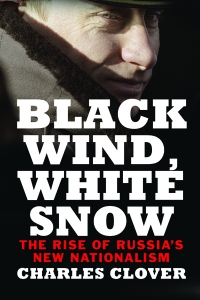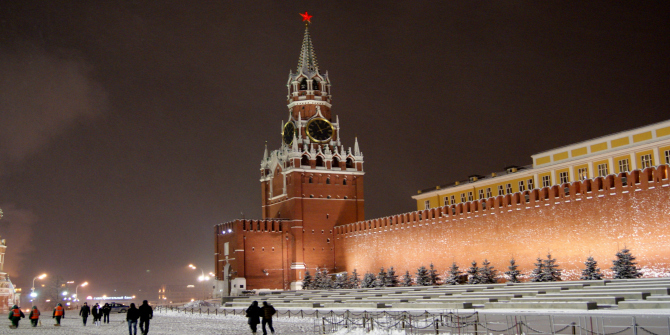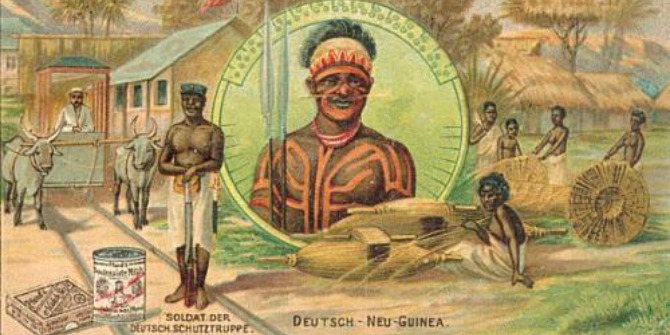In Black Wind, White Snow: The Rise of Russia’s New Nationalism, Charles Clover traces an intellectual history of ‘Eurasianism’, a theory of Russian national identity based on the idea of a primordial Eurasian civilisation, as a means of understanding contemporary Russian politics. This is a meticulously researched and engagingly written book, finds Ed Pertwee, deserving of a wide readership.
If you are interested in this review, you may also like to listen to a recording of Charles Clover’s LSE lecture, ‘Managed Nationalism Under Putin: An Experiment Gone Wrong’, held on 25 April 2016.
Black Wind, White Snow: The Rise of Russia’s New Nationalism. Charles Clover. Yale University Press. 2016.
 Keen observers of Russian politics may have noticed some strange terminology creeping into official rhetoric during Vladimir Putin’s third term as president, a new lexicon that seems somehow related to the regime’s more assertive foreign policy. Charles Clover, a former Moscow bureau chief for the Financial Times, offers some suggestive examples at the start of his fascinating new book, Black Wind, White Snow: The Rise of Russia’s New Nationalism. These include allusions by Putin to passionarnost (‘passionarity’), an ‘inner energy’ that determines the fate of great nations; the tendency to describe Russia as a ‘civilization state’ rather than a nation state; the use of the term ‘Atlanticism’ rather than ‘Western’; and Putin’s ambition to create a ‘Eurasian Union’ of former Soviet states (1-4).
Keen observers of Russian politics may have noticed some strange terminology creeping into official rhetoric during Vladimir Putin’s third term as president, a new lexicon that seems somehow related to the regime’s more assertive foreign policy. Charles Clover, a former Moscow bureau chief for the Financial Times, offers some suggestive examples at the start of his fascinating new book, Black Wind, White Snow: The Rise of Russia’s New Nationalism. These include allusions by Putin to passionarnost (‘passionarity’), an ‘inner energy’ that determines the fate of great nations; the tendency to describe Russia as a ‘civilization state’ rather than a nation state; the use of the term ‘Atlanticism’ rather than ‘Western’; and Putin’s ambition to create a ‘Eurasian Union’ of former Soviet states (1-4).
Clover argues that this new vocabulary signals the growing influence of ‘Eurasianism’, a form of Russian supra-nationalism based on the idea of a primordial Eurasian civilisation successively incarnated as the Scythians, Huns, Turks, Mongols, the Russian Empire and, most recently, the Soviet Union; a civilisation destined to be locked in a permanent geopolitical conflict with the ‘Atlantic’ world centred on the United States. Disentangling Eurasianist ideas and their influence on the Russian elite can help to explain some otherwise puzzling aspects of the Kremlin’s recent behaviour, according to Clover. For example, what sort of strategic calculus made it seem imperative to gain a toehold in eastern Ukraine in 2014, despite the inevitability of Western sanctions and the massive decline in the value of the rouble?
Much of Black Wind, White Snow comprises an intellectual history of Eurasianism. In the first of three parts, Clover shows how Eurasianist ideas circulated within White Russian émigré circles following the Bolshevik Revolution and Civil War. Struggling to deal with the trauma of their forced exile, a group of émigré intellectuals attributed the catastrophe of the revolution to Russia’s adoption of the philosophical ideas of European modernity. For these founders of the Eurasian movement, there was no such thing as social progress or a single historical trajectory common to all humanity. Instead, echoing the ideas of Oswald Spengler, there were discrete cultures and civilisations each defined by a common language, culture and geographical boundaries. Hence, they claimed to have discovered a unique ‘Eurasian’ civilisation destined to follow a different path of development to the West.
 Image Credit: Spasskaya Tower, Kremlin (Sergey Rodovnichenko CC 2.0)
Image Credit: Spasskaya Tower, Kremlin (Sergey Rodovnichenko CC 2.0)
Eurasianism was subsequently developed by the dissident Soviet historian, Lev Gumilev. The content and political influence of Gumilev’s theories are the focus of the second part of Clover’s book. During fourteen years spent in Siberian prison camps, Gumilev developed an alternative theory of history to the prevailing Marxist orthodoxy, based on his studies of the ancient steppe tribes of inner Asia. In this theory, ‘ethnoi’ (ethnic groups) rather than social classes were the basic units of history, and history was driven by ‘passionarity’, an irrational drive or energy, rather than by economic or material factors. Gumilev likened these ethnoi to organisms with their own life cycles. Hence, there was no universal history common to all mankind, and certainly not one that would end in the utopia of a classless society. While Gumilev was marginalised by mainstream academia, he became a well-known public intellectual in the USSR during the perestroika era.
The main keeper of the Eurasianist flame in the post-Soviet era has been Alexander Dugin. From being a Bohemian intellectual and underground political activist in 1980s Moscow to a professor at Moscow State University by the late 2000s, Dugin’s intellectual trajectory and political influence are the focus of the third part of Clover’s book. Dugin’s influence has sometimes been dismissed, and some of the evidence for his importance is circumstantial, albeit arresting. As Clover notes, Dugin has been ‘scarily, spookily right’ about the conflict in Ukraine, predicting the country’s breakup as early as 2010, using the term ‘Novorossiya’ to refer to the breakaway eastern provinces long before Putin did, even predicting the eventual design of the flag of the Donetsk Republic (12-13).
Patiently, and taking care not to overstate his case, Clover shows how neo-Eurasianism has become influential in Putin’s Russia. Dugin’s most famous book, Foundations of Geopolitics, was put together from notes Dugin had made for his fortnightly lectures at the General Staff Academy in the early 1990s. Foundations argued that the Cold War was merely the latest episode in a permanent conflict between Eurasian land power and Atlantic sea power. Its main theme was the need to defeat the global ‘Atlanticist’ conspiracy led by the US and NATO, which sought to contain Russia geographically and undermine it politically by spreading subversive liberal values.
Clover argues that Dugin’s arcane theories found a receptive audience among military and security personnel who feared that they would become irrelevant after the Cold War. Many of these subsequently entered the government under Putin. Foundations remains a key textbook on the syllabi of military academies in Russia. Moreover, following the ‘Rose’ and ‘Orange’ revolutions in Georgia and Ukraine respectively, the Kremlin pursued a strategy of co-opting Russian ultra-nationalism as a bulwark against liberalising and democratising forces. Dugin’s Eurasianist Youth Union was one of a number of nationalist street gangs supported by the Kremlin in the late 2000s with the aim of confronting pro-democracy activists.
Clover documents the gradual infiltration of Eurasianist themes into official discourse from the early 2000s to the establishment of the ‘Eurasian Union’ in 2015. It is unclear how direct Dugin’s influence is, or how far his theories are actually believed. What does seem clear is that by the eve of the Ukraine conflict, as the Yale historian Timothy Snyder has written, ‘Moscow had ceased to represent simply a Russian state with more or less calculable interests, but rather a much grander vision of Eurasian integration’.
As an exercise in intellectual history and political journalism, Black Wind, White Snow is first class: meticulously researched and engagingly written. It may seem slightly less compelling if approached from the perspective of historical sociology. Clover adopts an idealist approach to ideology that treats Eurasianism and other Russian nationalisms as autonomous, free-floating collections of ideas. Early in the book, he quotes John Maynard Keynes’s famous cliché that ‘madmen in authority, who hear voices in the air, are distilling their frenzy from some academic scribbler of a few years back’ (5). From this angle, the growing influence of Eurasianism ‘is testament to the “scribblers”, to their ability and the extent to which it has now become possible to construct order entirely out of words and symbols’ (332).
However, it seems significant that Eurasianist ideas have flourished in three particularly tumultuous periods of Russian history: the immediate aftermath of the Bolshevik Revolution and Civil War; the Stalinist Terror and the brutality of the gulag system; and the upheavals that have followed the collapse of the USSR. Surely there is a closer connection than Clover implies between the pessimistic and conspiratorial themes of Eurasianism and the socio-structural ‘crises’ in which they have arisen?
Although more could have been done to explore these connections, Black Wind, White Snow remains an important and timely book, which deserves a wide readership. It will be of interest not only to scholars of nationalism, but also to general readers with an interest in Russian history and politics.
Ed Pertwee is a doctoral student in the Department of Sociology and Centre for the Study of Human Rights at the London School of Economics (LSE). His main research interests are in the areas of political sociology, and the sociology of race and ethnicity. Find him online at edpertwee.com.
Note: This review gives the views of the author, and not the position of the LSE Review of Books blog, or of the London School of Economics.








1 Comments